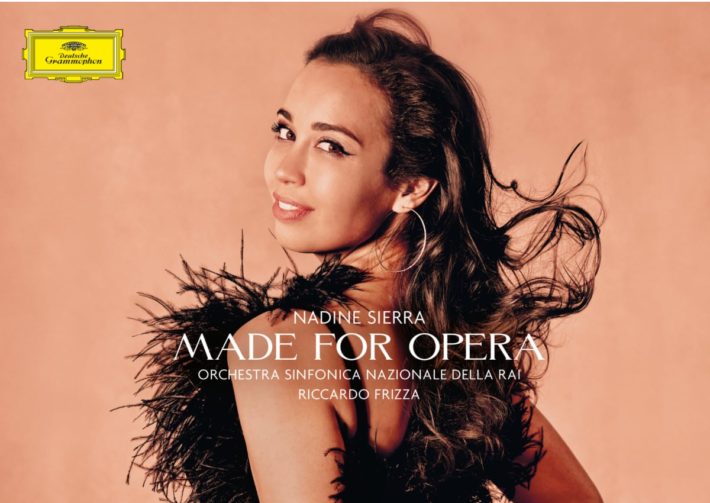Nadine Sierra’s second solo album finds inspiration in three emblematic heroines – Violetta (Verdi), Lucia (Donizetti), and Juliette (Gounod). On a first glance, her choices could make us think that this might be along the lines of a ‘greatest hits’ compilation, but a closer reading of her liner notes reveals much more: these roles were mindfully selected based on how different women in her family navigated social norms and familial expectations.
The soprano’s Violetta in Act 3 has a theatrical aspect to it – the spoken recitative (the reading of the letter in “Teneste la promessa”) seemed initially subdued to me but ultimately makes sense when we envision a emotionally weary woman whose illness has also left her physically fragile. In “Addio del passato” (track 6), her voice is filled with a heaviness that represents a resignation to circumstance. However, we also hear the moments where she expresses the wrenching realizations of loss. Sierra’s control of dynamic shading is a marvel to behold: the brief appearance A major (4:30) gives us a last burst of hope to hold onto, but her denouement communicates the crushing finality of Violetta’s fate. I reviewed another equally fine performance of this scene by soprano Ermonela Jaho back in 2020. The interpretation is quite different: Jaho’s Tenesta is more poetic in the way her voice moves and delivers a strong element of longing; Addio has a tighter vibrato throughout and thus reveals a more tense and defiant Violetta.
Lucia di Lammermoor’s famed ‘mad scene’ (tracks 11-14) has seen landmark performances by the likes of Joan Sutherland, Maria Callas, and Nathalie Dessay. An interesting note is that the original scoring used glass harmonica as an accompaniment, replaced most commonly by a flute as it is here (Sierra did in fact perform with the originally intended instrument at Venice’s La Fenice in 2017). Her coloratura qualities shine in the Andante (“Il dolce suono”) – tone clear as a bell and runs and glissandi absolutely pristine. Also impressive is her ability to change dynamic and vocal color on a dime even in the highest of registers. The Lucia she presents is beautifully sad and youthful, different (but no less effective) from Callas’ (1959 with Tullio Serafin) which for me exudes more tragedy. Callas has a slightly huskier voice and more emphatic phrasing, embodying a protagonist trapped in an inescapable agony.
Related Posts
- Review: “Reine de Coeur” Hanna-Elisabeth Müller, Soprano
- Review: “El Nour” – Fatma Said, Soprano
- Review: “Phidylé” – Kateřina Kněžíková, Soprano
Standard improvisational practice in this scene leaves a lot of room for a soprano to impress with vocal acrobatics. Sierra certainly doesn’t shy away in this regard, using these opportunities to showcase an effortless array of high notes. Ardon gl’incensi (track 13) has some admirably coordinated thirty-second notes between voice and flute, whose synchronicity reveals the delightful harmonies. Lucia has a pleading quality here, which of course takes a sharp turn in a well-done Spargi d’amaro. However, none for me will quite replace Nathalie Dessay’s performance at the Metropolitan Opera (2007). Her prancing two-note phases deliver a bitter irony and she builds the finale’s momentum so well that it’s not hard to picture the heroine nearly hyperventilating with madness at the conclusion.
The selections from Gounod’s Roméo et Juliette include the joyful “Ah! Je veux vivre!” (track 15). This is yet another technically scintillating performance that shows the agility and incisiveness of Sierra’s voice. Her Juliette is wonderfully carefree, with a natural sway that complements the orchestra’s lively and buoyant waltz. I liked hearing how the voice gradually intertwines with the ensemble’s rising chromatic melody (1:00), which brings a new harmonic angle to the vocal line. “Amour, ranime mon courage” captures the courageous side of Juliette–a tragic portrayal with respect to her eventual fate that evokes sympathy from the listener.
Sierra’s liner notes give concise yet informative synopses as well as the vocal features and challenges each role entails. Her own forward takes center stage, however; it is personal and humble but also empowering. When considered in tandem with the excellent performances from both the singer and the Orchestra Sinfonica Nazionale della Rai, we cannot help but have a newfound respect for these iconic tragic heroines. Warmly recommended.

Made for Opera
Nadine Sierra – Soprano
Orchestra Sinfonica Nazionale della Rai
Riccardo Frizza – Conductor
Deutsche Grammophon, CD 4860942
Recommended Comparisons
Read more classical music reviews or visit The Classic Review Amazon store
Follow Us and Comment:
[wd_hustle id=”HustlePostEmbed” type=”embedded”]











